
One hundred years ago on 19th February 1921, Egon Oldendorff (1900-1984) was made a partner in the shipping company of Lilienfeld & Holmuth in Hamburg two days after his 21st birthday. He became the sole partner when Lilienfeld died at the end of 1921. During 1922/23, his firm acquired two coasters of 600 grt in Planet and Komet, both already nearly forty years old. Planet was trapped in the ice in the Baltic during the winter of 1928/29 and received bunkers and supplies from the German battlecruiser Schleswig-Holstein, and later became a total loss in November 1943 after more than 62 years of service.
Egon Oldendorff had been born on 17th February 1900 as the youngest of three children at Dorum near Bremerhaven and went to school in Dorum and Lehe. His father Ludolf Oldendorff had been a banker and auctioneer, and at the age of 16 years Egon went to work on the farm of his uncle Gustav Schmidt-mann in the small village of Alsum. He was called up for Army service towards the end of World War I, and was discharged from the Army on 31st December 1918. He worked in his father’s bank until June 1920, and then had become a trainee in the shipping firm of Lilienfeld & Holmuth. He became very acquainted with the German coastal and North Sea trades.
Egon moved his office to Lubeck in 1925, his company was now called Nordische Dampfer Reederei, and acquired an even older coaster in 1926, this time built for Turnbull at Whitby back in 1871 as Whitehall, and was renamed Magnet. She was sold to Italian owners three years later, and unfortunately sank 15 miles SW of Cape Spartiventi in May 1932 while on a voyage from Porto Empedocie to Pescara with rock salt. The original funnel colours of the fleet were black with a white ‘EO’ on a blue band. Egon had a small fleet of six short sea traders in 1932 with names beginning ‘Nord’, which became a traditional Oldendorff nomenclature. The veterans Nordstern, Nordland, Nordlicht, Nordmark, Nordkap and Nordfels had an average age of 34 years, with Nordfels being the former Burnett Steamship Company of Newcastle collier Towneley built in 1904 by Wood, Skinner of Gateshead.
The steamer Peter Benoit of 1,359 grt built in 1902 was purchased in 1932 and was the first ship to be named after a family member as Gisela Oldendorff. The Depression years were just as severe in Germany as in England, with most of the six strong fleet laid up for long periods, particularly in the bad winter of 1932. A fledgling liner service from Germany to Scandinavia was abruptly stopped in 1929 and was never to be revived.
The end of the Depression and the rise in freight rates in 1936 for cargoes of pyrites from Spain to Northern Europe, or pitch from London to the Mediterranean meant a revival in trading. More veteran steamers were purchased, including an engines aft ‘Laker’ built by the Wallsend yard of Swan, Hunter & Wigham Richardson Ltd. in 1903 as Westmount and renamed Ludolf Oldendorff. Another purchase in 1936 was a steamer built back in 1893 as George Mahn of 1,101 grt and renamed after his son Klaus, born in 1933.
In 1939, Egon expanded from the North Sea and Baltic coal and timber trades into tramping with the purchase of the Dutch ship Leersum of 3,986 grt, completed in 1918 as Leersum at Capelle in Holland for the Oostzee N.V. Mij and renamed Henning Oldendorff. She was captured in the Denmark Strait by the British cruiser Colombo on 17th November 1939 while trying to reach Germany with iron ore from Huelva in Spain. By the end of the war, his small fleet of a dozen steamers had been reduced to only two by war losses. Gisela Oldendorff of 1,361 grt and Nordmark of 1,060 grt were too small to be surrendered to the victorious Allies and went back into service in 1947 under strict supervision of the Allies.
No new ships, except coasters, could be ordered or built in German yards until 1950 under the terms of surrender, when four new Oldendorff vessels came into service. These were the engines ‘midships Birte Oldendorff, Dorthe Oldendorff and Irene Oldendorff of around 3,000 dwt for the North Sea and Baltic trades, and Klaus Oldendorff of 5,500 dwt for tramping. Two of the smaller trio had been repossessed by banks shortly after their completion, and thus Egon was able to buy them at competitive lower prices. Irene Oldendorff sank three miles off Borkum island on 31st December 1951 while carrying coke, and unfortunately all of her crew were lost. The remaining pair were chartered out to Norddeutscher Lloyd, KNSM of Holland or Canadian Pacific on liner routes.

Two new ‘tween deck traders of 4,650 dwt were built as Ludolf Oldendorff and Dora Oldendorff in 1952/53 on dimensions of overall length 349.0 feet, and loaded draft of 20.3 feet, by the Orenstein yard in Germany. They were often chartered out to Norddeutscher Lloyd (NDL) to load copper ore at Callao in Peru and bagged coffee beans in Colombia for U. S. Gulf and Eastern Seaboard ports. They both were frequently sent up the St. Lawrence Seaway after its opening in April 1959, Dora Oldendorff making 33 voyages and Ludolf Oldendorff making 37 voyages on charter to Canadian Pacific. KNSM charters to the Caribbean saw them loading in 25 ports in the Caribbean, with other NDL charters for bagged coffee beans from Cabedelo near Pernambuco in Brazil.
A veteran Dutch tramp of 6,320 dwt was purchased in 1951 and renamed Henning Oldendorff, having been built back in 1920 as Stad Arnhem at Dordrecht for Halcyon Lijn. Another veteran Dutch tramp, Winsum of 5,255 dwt, built in 1921 by the Antwerp Engineering Company at Hoboken with a triple expansion steam engine built at Sunderland for Vinke & Company, was purchased in 1953 and renamed Dietrich Oldendorff. German shipyards got into their stride in 1956/57 with five new ships of between 10,780 dwt and 15,265 dwt, completed as the five hold engines ‘midships Eibe Oldendorff, Hinrich Oldendorff, Catharina Oldendorff, Helga Oldendorff and Johanna Oldendorff, and were joined by a purchased second hand tramp renamed as Christoffer Oldendorff, but built back in 1937 at Burntisland as Ginnheim. Two engines aft North Sea traders were completed by the Unterweser yard at Bremerhaven in Imme Oldendorff of 2,712 dwt in 1953 and Hille Oldendorff of 3,200 dwt in 1956.
The first engines aft bulker in the fleet was completed in 1957 by the Flensburger yard as Magdalena Oldendorff of 15,400 dwt, and served for 14 years until damaged by fire in November 1971 while dry-docked at Bremerhaven, and she was then sold to a Norwegian owner. By 1962, a fleet of 26 ships was being traded, including ten coasters in the North Sea and Baltic coal and timber trades. A new quartet of engines aft motorships of 4,385 dwt entered service that year as Christiane Oldendorff, Erna Oldendorff, Jobst Oldendorff and Hans Oldendorff with accommodation for four First Class passengers and equipped with ten derricks to serve three holds, with number one hold as a well deck. The last ship with a ‘Nord’ prefix to her name, Nordheim, was sold off shortly afterwards. New bulk carriers entered the fleet, including Klaus Oldendorff of 14,675 dwt, and engines aft bridge ‘midships Birte Oldendorff of 15,450 dwt, and Henning Oldendorff of 30,500 dwt in 1963, with the latter as the new flagship of the fleet, and followed by her sister Christoffer Oldendorff by the end of 1963.
Increasing sizes of bulkers by 1967 with higher service speeds of 16 knots included Helena Oldendorff, Regina Oldendorff, Dietrich Oldendorff, Tete Oldendorff, Rixta Oldendorff and Bernhard Oldendorff of 54,110 dwt. The Panamax bulkers Emma Oldendorff and Eckert Oldendorff were completed in 1969/70 by the Bremer Vulkan yard, and a further quartet was completed by the ‘3 Maj’ yard at Rijeka in Jugoslavia in1974/75 as Birte Oldendorff, Dora Oldendorff, Helga Oldendorff and Ludolf Oldendorff.
Helena Oldendorff sailed from Emden with coal for Japan in April 1967 on a seven month world voyage. She then crossed the Pacific in ballast to Peru to load phosphates for the Eastern Seaboard of the U.S.A, where she loaded coal again at Newport News for Japan via the Panama Canal and returned in ballast to the U.S. Gulf to load 36,650 tonnes of grain for Rotterdam. Grain, ores and coal were the staple trades of the Oldendorff bulker fleet e.g. Richards Bay to Wilhelmshaven with coal, Ghent to Newport News to load coal, Philadelphia to Puerto Ordaz in Venezuela to load iron ore, and Narvik to Antwerp with iron ore.

The first of eleven Oldendorff vessels to be flagged out was Catharina Oldendorff in 1971 to companies such as Wursata, Holsatia, Rhenania and Westfalia with vessels wearing ‘W’, ‘H’ and ‘R’ on the central funnel band instead of ‘EO’. Regina Oldendorff was flagged out as Bold Challenger and Tete Oldendorff was flagged out as Nautic Pioneer for use as floating grain stores at Hamburg during 1984/85. The last three of nine ‘SD14s’ built at Sunderland were also flagged out as Good Faith, Future Hope and Globe Trader, with Future Hope wrecked at Tomakonai in Japan on 26th January 1993 in a seriously bad position on rocks. She was cut up into three pieces and refloated and rebuilt with the name of Nordhope.
In 1971 on the 50th Anniversary of the Egon Oldendorff fleet, some 33 ships of 726,910 dwt were owned and employed 1,100 seafarers and 54 office staff. Charters to KNSM of Holland for Caribbean trading were taken up by four ‘German Liberty’ types of 15,000 dwt, and they were renamed after the Dutch towns of Bennekom, Baarn, Breda and Barneveld during 1971/75. This general cargo ‘Liberty’ replacement type was equally happy with bulk cargoes or breakbulk cargoes e.g. bulk grain, coal or other heavy cargoes, or coiled wire from Trois Rivieres on the St. Lawrence to European ports. By 1984, the fleet was composed of equal numbers of bulkers up to Panamax size, and break bulk ships, with also two VLCCs of 240,800 dwt completed in 1975 as Niedersachsen and Schleswig-Holstein that had disastrous trading results. They were laid up at Geltinger Bucht in the Baltic or Dubai in the Persian Gulf for many years until they were sold off in 1984 for a fraction of their enormous building costs.

HENNING OLDENDORFF
Henning Oldendorff was born in June 1957 as the youngest son of Egon Oldendorff, with Klaus Egon Oldendorff as the eldest son, and also a daughter, Birte. Henning Oldendorff underwent extensive shipping training in Hamburg, London, New York and San Francisco before taking over the reins of management in 1980. Egon Oldendorff died on 9th May 1984 aged 84 years, with Henning Oldendorff inheriting and succeeding to the control of the huge bulker business of Reederei Oldendorff as the majority shareholder.
New Panamax bulkers were being completed in 1984 for the flagged out Wursata and Reinata companies named Baltic Mermaid, Marine Ranger and Sea Scout. Marine Ranger sailed on her maiden voyage to Damman in Saudi Arabia and then on to Murmagao in India to load manganese ore for Barcelona. Two earlier Panamax bulkers completed in 1974 had also been flagged out as Ocean Traveller ex Birte Oldendorff, and United Venture ex Helga Oldendorff. Rixta Oldendorff and Regina Oldendorff of 28,000 dwt were registered under the British flag in 1986, while two ‘Ecoflex’ multi-purpose ships were building at the Southwick yard of Austin & Pickersgill Ltd. in Sunderland. Johanna Oldendorff and Dietrich Oldendorff were of 15,987 grt and 23,186 dwt as economical and flexible manning ships with a crew of 24 and suitable for long term charter to liner companies e.g. The Shipping Corporation of India.
An owned fleet of thirty bulkers was being traded in 1990, with six of Panamax size and included two of 23,600 dwt purchased from the United Arab Shipping Corporation (UASC) in 1987 and renamed Christoffer Oldendorff and Magdalena Oldendorff. Two ‘Passat XL’ types were completed in 1989 by the Warnemunde yard as Beate Oldendorff and Maria Oldendorff, and were sent immediately to the Jurong yard in Singapore for lengthening to increase their container carrying capacity to 1,100 TEU.
Container ships were also acquired for long term charters to Senator Line of Bremen, with London Senator and Tokyo Senator of 1,800 TEU, and one of a quartet of 2,100 TEU container ships completed in 1991 for Senator Line, with the other three sold to other German owners before delivery. A quartet of big ‘French Polish’ ro-ro/container ships were acquired from Polish Ocean Lines for charter to Blue Star Line, MSC of Italy, Canada Maritime, Neptune Orient Line of Singapore and other container lines. Another interesting container ship purchase in 1990 was Monte Pascoal, completed by the Walker Naval Yard in 1980 as Dunedin. She was then lengthened by the Flender Werke yard at Lubeck to increase her capacity to 1,400 TEU, and continued on her Hamburg Sud charter, switching to their Columbus Pacific trades as Columbus Olivos later in 1990.
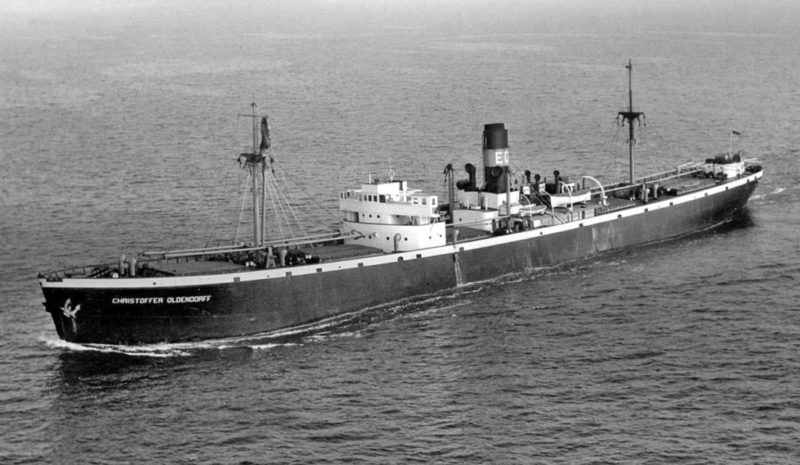
Egon Oldendorff (Asia) Ltd. was formed in Hong Kong in 1989, and two Danish multi-purpose ships, Jytte Skou and Benny Skou, were acquired for charter to Tasman Asia Shipping Company (TASC) as T.A. Navigator and T.A. Mariner. TASC became a very important client of Oldendorff in the 1990s in forestry products markets, with eight multi-purpose ships having ‘T. A.’ or ‘Tasman’ prefixes to their names loading logs at beautiful Otago Bay in New Zealand for Asian ports. T.A. Explorer (Dietrich Oldendorff), T.A. Voyager (Johanna Oldendorff), T.A. Adventurer (Maria Oldendorff) and T.A. Discoverer (Beate Oldendorff) loaded logs in their holds, general cargo in their ‘tween decks, and a large number of containers on deck for their voyages to South East Asia. TASC operated three distinct routes out of New Zealand to North Asia, East Asia and South East Asia, with many cargoes being lifted from Bluff on the southern tip of South Island for North Asia. However, Tasman Trader and Tasman Discoverer loaded at Bluff in June 2000 for East Asia as an exception, and had the usual ‘Tasman Shipping’ in bold white letters on both sides of their hulls.
Fleet expansion continued in mid 1990s with eight multi-purpose ships completed in Japan of 22,160 dwt equipped with four 30 tonne cranes, and two geared bulkers of 23,746 dwt ended their five year charters in 1995 from Hyundai Merchant Marine. The similar Emma Oldendorff, Eckert Oldendorff and Eibe Oldendorff were chartered out to Lineas Mexicanas of Mexico as Maya, Mixteco and Magallanes, and to CCNI of Chile as CCNI Valparaiso.
Henning Oldendorff purchased the Flensburg yard of Flensburger Schiffbau Gesellschaft in March 1990 and began to modernise it. A series of multi-purpose ships were built for the company fleet, including Tasman Adventurer, Tasman Discoverer and Lydia Oldendorff, part of a dozen such vessels of 21,675 dwt.
Large ro-ro ships were also built for Cobelfret N. V. of Belgium, and six ro-ros for charter to the British Government to carry tanks and heavy equipment and managed by Andrew Weir Ship Management. The yard was sold in a management buy-out to Managing Director Peter Sierk and a private equity group.
Henning Oldendorff became Chairman in 2001 of the newly formed Oldendorff Carriers Gmbh, as well as being the Chairman and owner of the big fleet of bulkers of Egon Oldendorff Gmbh, and also one of the two main shareholders of the Maritime and Merchant Bank ASA in Oslo. A happy Oldendorff family occasion had occurred in July 1995 when Linda Oldendorff, aged 18 months and the second daughter of Henning, christened a Mark V Panamax bulker of 75,000 dwt after herself at the Copenhagen yard of Burmeister & Wain Ltd. Henning Oldendorff has three daughters in Linda, Lucy and Lily and he is married to Beate Oldendorff.
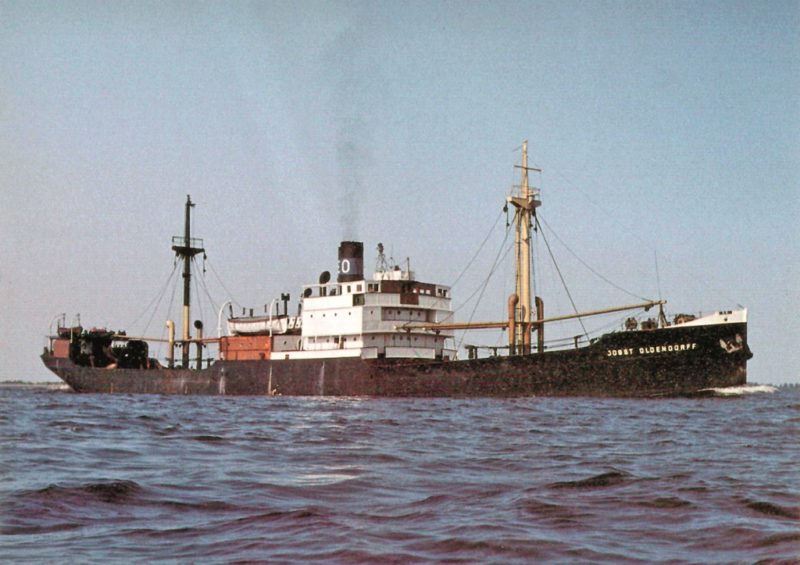
Henning Oldendorff had formed Concept Carriers in 1995 and merged this company together with Egon Oldendorff Gmbh to form Oldendorff Carriers Gmbh in 2001. The former Tatry of Czechoslovak Ocean Shipping, a Panamax bulker built in 1990, was renamed Alwine Oldendorff and had a chequered career in the fleet after being purchased in 1998. She was attacked by pirates in the Mediterranean in 1999, then suffered an engine breakdown on the U.S. West coast, and was detained briefly in Pakistan and Japan in 2003. She was then sold off to Greek owners in 2006 after a financially unrewarding career of eight years. Forty bulkers and multi-purpose ships were owned in 1998 including the new Hugo Oldendorff of 44,000 dwt and four others of Panamax size, as well as a big time chartered fleet operated from the Head Office in Lubeck.
The large fleet at the Millennium began to receive the first of ten eleven Open Hatch bulkers of 31,350 dwt from the Saiki Jukogyo yard at Saiki in Japan as May Oldendorff. On her maiden voyage in August 2000, she loaded a part cargo of tissue paper in Indonesia for delivery at Blyth in Northumberland at the end of October. The class were very suitable for carrying logs and forestry products loaded in New Zealand at Otago Bay and Bluff, and nine sisters followed over the next four years in Albert Oldendorff, Carl Oldendorff, Cathrin Oldendorff, Eduard Oldendorff, Gertrude Oldendorff, Gitta Oldendorff, Hinrich Oldendorff, Lily Oldendorff, Lucas Oldendorff, and Tete Oldendorff, with a similar number of sisters completed for UBC Bulkers of Philadelphia.
An ‘Arctic 21’ multi-purpose vessel owned by Oldendorff hit the headlines on 14th June 2002 when she became stuck in pack ice in the Antarctic. She had been built by the Valmet yard in Helsinki as the Russian owned Nizhneyansk of 19,950 dwt and was purchased in 1996 and renamed Magdalena Oldendorff. She made her first visit to the Indian Maitri base in Antarctica in June 200, but became stuck on her second visit. Two weeks after her rescue call, the South African polar research vessel S. A. Agulhas was close enough to fly off its two helicopters and rescue 21 Russian scientists and take them back to Cape Town. However, efforts to extricate Magdalena Oldendorff from the ice proved difficult and she overwintered in Antarctica until she freed herself in late November 2002 and arrived back at Cape Town before Christmas.
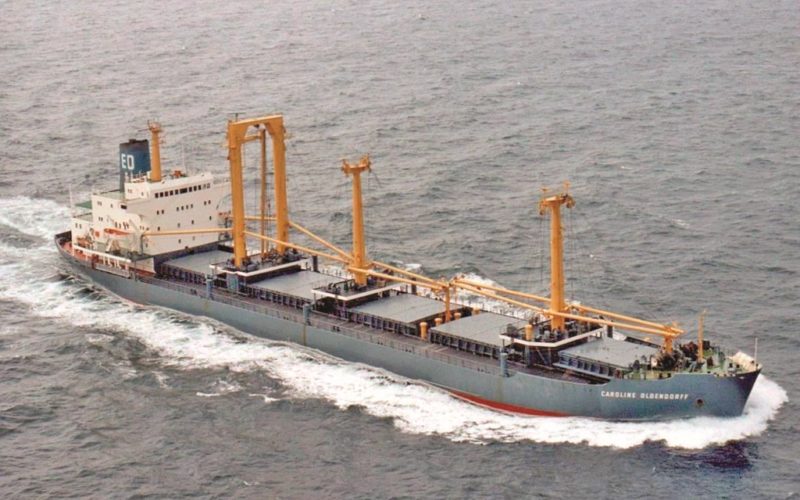
The Oldendorff fleet in 2002 comprised over 150 owned and time chartered vessels, which grew even larger to a big fleet of 230 owned and time chartered vessels in 2006. The biggest bulker in the fleet in 2006 was the former ore carrier Hedwig Oldendorff of 155,863 dwt and built as Cast Orca for Cast Lines transatlantic service in 1983 by Hyundai at Ulsan in South Korea with a service speed of 13 knots from a B & W oil engine. She was purchased in January 2005 from Maritime S. A. of Greece for £25 million to include the balance of a time charter to Coeclerici until June 2006 at a rate of $37,500 per day. This was the same sale price as when she was sold ten years earlier, and she gave four years of trading for Oldendorff e.g. from the St. Lawrence to Rotterdam with iron ore before being broken up in Bangladesh in 2009.
A new service began in 2007 with two ships in the Zeebrugge based parcel and project cargo carrier Oldendorff Express Lines (OXL), formerly known as CEC of Denmark. This service was 60% owned by Oldendorff and 40% by Flamar of Belgium, and was then extended to operate a specialist fleet of twenty ro-ro and heavy lift ships on a tramp liner service between Northern Europe, Mediterranean, Black Sea, Red Sea, Persian Gulf and Far East ports for project, military, oversized and overweight heavy lift items. A Branch Office was set up in Dubai and project cargo up to 650 tonnes in weight was handled. The vessels OXL Nomad, OXL Sultan, OXL Triumph, OXL Blue Sea and OXL Lotus have been used on this service.
Henning Oldendorff sold a large part of his bulk carrier fleet between 2003 and 2008, and replaced them with new bulk carriers when the newbuild prices at Far Eastern shipyards had fallen to acceptable levels. Handysize bulkers such as Maria Oldendorff, Regina Oldendorff, Helena Oldendorff and Ingrid Oldendorff of 37,500 dwt, were followed by eight such bulkers sold and leased back to the company from the Tufton Oceanic Shipmanagement Fund in a $250 million deal in late 2007.
A Capesize ore carrier of 227,200 dwt was purchased from Japanese owners in 2010 and renamed Beate Oldendorff, and there were also four other Capesize bulkers in the fleet in John Oldendorff (ex Lowlands Prosperity), Bulk Asia, Bulk Europe and C. Prosperity. New smaller bulkers continued to be purchased including Anna Oldendorff and Zella Oldendorff of 50,326 dwt in 2012, and new ones completed included Lucy Oldendorff of 32,500 dwt. Linda Oldendorff, one of three daughters of Henning, launched the Capesize bulker of 207,500 dwt with her name on 14th September 2014 at the Hyundai yard in South Korea. She was the first of 40 Capesize bulkers to be completed for the company over the next five years with overall lengths of 300.0 metres and moulded beams of 50.0 metres.
Four Handysize bulkers were chartered out by Oldendorff in 2014 to Tasman Maritime Pacific (Shanghai) Ltd. and Spirit Shipping Inc for Far Eastern bulk cargoes e.g. coal, ores and forestry products and logs, using the owned bulkers renamed as Auckland Spirit, built in 2003 as Lily Oldendorff, Melbourne Spirit completed in 2013, Singapore Spirit built in 2002 as Lucas Oldendorff, and Admiralty Spirit built in 2000 as Albert Oldendorff. This quartet of 36,000 dwt wore charterer’s funnel colours of light blue with a central white band bearing a logo of three blue arrows, and have also seen in Indonesia, U.S.A. ports, the St. Lawrence, and British Columbia loading logs.
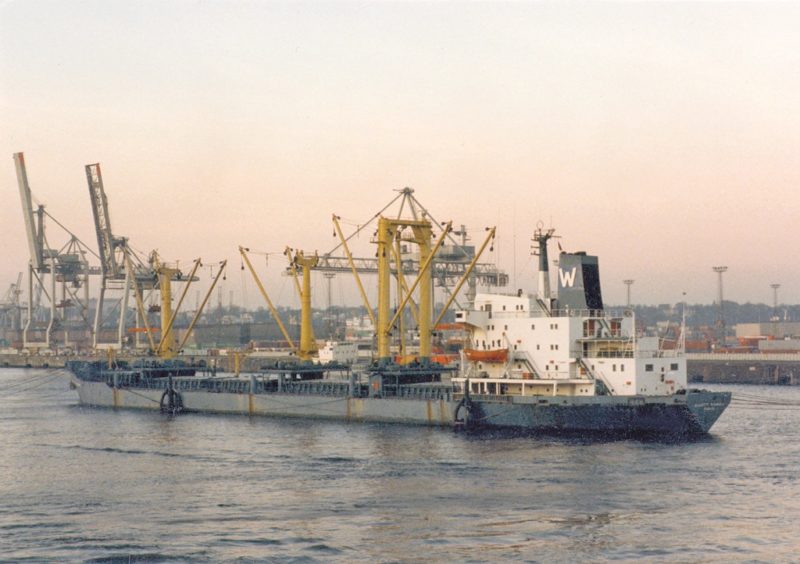
Eleven ‘E’ class Open Hatch eco bulkers were completed by the Jinling yard in China between 2014 and 2016. They are of 38,700 dwt on dimensions of overall length 180.0 metres, moulded beam of 30.0 metres and loaded draft of 10.5 metres with box shaped holds and equipped with four deck cranes of 45 tonnes capacity and bulwark vertical fittings for restraining deck cargoes of timber or windmill towers, blades and nacelles. They are named Eckert Oldendorff, Edward Oldendorff, Edwine Oldendorff, Eibe Oldendorff, Elisabeth Oldendorff, Elsa Oldendorff, Emma Oldendorff, Erna Oldendorff, Ernst Oldendorff, Edgar Oldendorff and Eike Oldendorff.
The revenue of the company had reached over five billion U.S. dollars in 2014 and the company had over 4,000 seafarer and shoreside employees. The fleet of 110 owned vessels and around 600 time chartered vessels today carry 320 million tonnes of cargo per annum. The Head Office is at Lubeck in Funfhausen, with Branch offices throughout the world. Henning Oldendorff became Chairman of all of the Oldendorff companies in 2003, with a new Chief Executive Officer appointed in Peter Twiss, a Canadian shipping expert who had joined the company in 1997. This huge owned and time chartered fleet can be summed up in 2020 as comprising the following classes of bulker:-
65 Capesize bulkers of 180,000-208,000 dwt named Beate Oldendorff, Helga Oldendorff, Hille Oldendorff, Lavinia Oldendorff, Leopold Oldendorff, Linda Oldendorff, Ludolf Oldendorff, Luise Oldendorff, Lydia Oldendorff, Magdalena Oldendorff, Magnus Oldendorff, Margret Oldendorff, Marlene Oldendorff, Martha Oldendorff, Mathilde Oldendorff, Max Oldendorff, May Oldendorff, Mina Oldendorff, Moritz Oldendorff, Hubertus Oldendorff, Hanna Oldendorff, Hannes Oldendorff, Hauke Oldendorff, Helena Oldendorff, Hera Oldendorff, Hermine Oldendorff, Heinrich Oldendorff, Hedwig Oldendorff, Hendrik Oldendorff, Hermann Oldendorff, Heide Oldendorff, Henriette Oldendorff, Hinrich Oldendorff, Hugo Oldendorff, Hans Oldendorff, Hagen Oldendorff, Harry Oldendorff, Hauke Oldendorff, Friedrich Oldendorff and Henry Oldendorff, with four as yet unnamed from the Jiangsu and Taizhou yards in China. Time chartered tonnage accounts for the remaining Capesize bulkers.
77 Suezmax bulkers of 100,000-160,000 dwt named Birte Oldendorff, Philipp Oldendorff, Penelope Oldendorff, Peter Oldendorff, Pia Oldendorff, Patricia Oldendorff, Paul Oldendorff, Regina Oldendorff, Rixta Oldendorff, Rik Oldendorff, Robert Oldendorff, Roland Oldendorff, Richard Oldendorff, Redmer Oldendorff and William Oldendorff. Time chartered tonnage accounts for the remaining Suezmax bulkers.
54 Post Panamax bulkers of 82,000-100,000 dwt named Albert Oldendorff, Catharina Oldendorff, Charlotte Oldendorff, Cornelie Oldendorff, Caroline Oldendorff, Conrad Oldendorff, Christine Oldendorff, Carl Oldendorff, Cora Oldendorff with the remainder time chartered.
85 Kamsarmax bulkers of 82,000 dwt named Gebe Oldendorff, Georg Oldendorff, Gertrude Oldendorff, Gisela Oldendorff, Gerdt Oldendorff and Gretke Oldendorff, Kaspar Oldendorff, Kendra Oldendorff, Katja Oldendorff, Kilian Oldendorff, Kim Oldendorff, Kira Oldendorff, Kirsten Oldendorff, Klara Oldendorff, Knut Oldendorff, Kai Oldendorff with two more on order and the remainder time chartered.
30 Panamax bulkers of 72,000 dwt named Theodor Oldendorff, Trina Oldendorff with the remainder time chartered.
150 Supramax bulkers of around 64,000 dwt named Benjamin Oldendorff, Britta Oldendorff, Beate Oldendorff, Indra Oldendorff, Iris Oldendorff, Ilsabe Oldendorff, Imme Oldendorff, Irene Oldendorff, Ingrid Oldendorff, Ingmar Oldendorff, Isa Oldendorff, Jan Oldendorff, Jacob Oldendorff, Jens Oldendorff, John Oldendorff, Jonas Oldendorff, Julius Oldendorff, Johan Oldendorff, Jobst Oldendorff, and six as yet unnamed from the Qingshan yard in China with the remainder time chartered.
86 Handysize bulkers of 35,000-38,700 dwt named Dora Oldendorff, Dorothea Oldendorff, Dorthe Oldendorff, Edward Oldendorff, Eibe Oldendorff, Eckert Oldendorff, Edwine Oldendorff, Elisabeth Oldendorff, Elsa Oldendorff, Emma Oldendorff, Ernst Oldendorff, Edgar Oldendorff, Eike Oldendorff, Erna Oldendorff, Lily Oldendorff, Lucy Oldendorff, Vanessa Oldendorff, Melbourne Spirit, Auckland Spirit, Admiralty Spirit, Singapore Spirit, Bulk Trader, Midland Trader, and Hansa Baltica with the remainder time chartered.

Jobst Oldendorff of 61,122 dwt and built at Nantong in 2014 was loading biomass pellets at Port Arthur (Texas) on 28th February 2017 when a fire broke out on a conveyor belt at 1500 hours, with burning pellets falling into her holds causing a fire in the holds, which took four hours by the fire fighting authorities to extinguish. After removal of damaged cargo, she sailed to the Tyne to unload the biomass pellets in April 2017. She was then chartered out for one year as CL Christina during 2018/19, and was loading a bulk cargo in Amazonas State at the important bulker port of Itacoatiara between Santarem and Manaus in May 2020.
Two Handysize bulkers delivered in December 2018 and April 2019 as Christiane Oldendorff and Christopher Oldendorff have interesting histories. They have been taken on long term charter by a major international trading house and renamed Midland Trader and Hansa Baltica and registered in Madeira. They were originally ordered back in June 2012 from the Samjin Shipbuilding Industries yard at Weihai in China, however this Korean controlled yard got into financial difficulties and Oldendorff received back their down payments plus 6% interest in 2015. They were reordered in July 2017 as ‘Fesdec’ eco bulkers equipped with four cranes of 35 tonnes capacity and powered by a Wartsila diesel engine to give a service speed of 15 knots.
Georg Oldendorff offloaded a cargo of 61,800 metric tonnes of soya beans on 28th January 2020 from the bulk carrier Hispania Graeca of Limassol, which had suffered major engine failure in South Africa. Georg Oldendorff successfully delivered the cargo for the client in China. Lydia Oldendorff loaded a record cargo of 207,500 tonnes of coal at Puerto Bolivar in Colombia for Flushing in Holland in November 2019. Puerto Bolivar ships 30 million tonnes of coal per annum from one of the biggest coal shipment terminals in South America. A big Contract of Affreightment was signed in early 2020 with the Bangladesh Chinese Power Co. Ltd. (BCPCL) for the carriage of between 3.8 to 4.5 million tonnes of cargo per annum from Indonesia and Australia. The contract runs for five years, and the cargo will be transhipped in the Andaman and Nicobar Islands in the Bay of Bengal before being delivered to the power generation plant at Payra in Bangladesh. A total of 750 complete sets of wind turbine towers, blades and nacelles have been carried between 2002 and 2015.
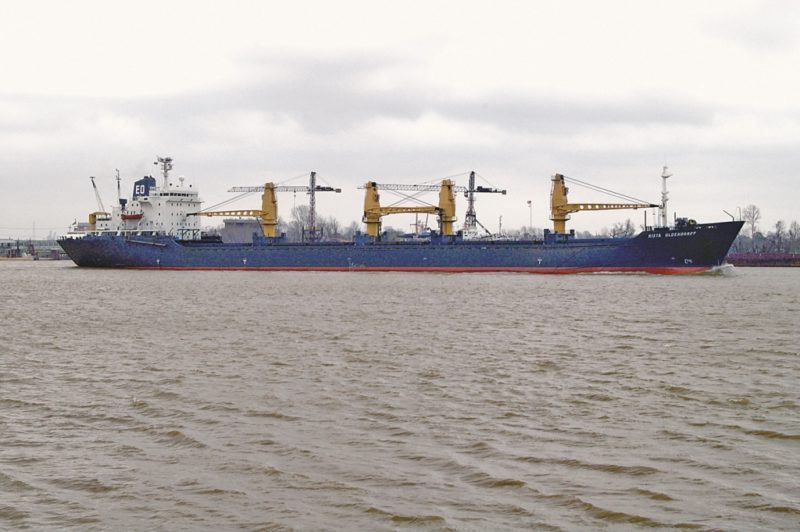
OLDENDORFF SELF DISCHARGING BULKERS
The self-unloading bulker market was entered in 1991 in a joint pool with Canada Steamship Lines (CSL). Two self-discharging bulkers were purchased while on charter to Foster Yeoman Ltd. of the U.K. in the new sisters of 77,500 dwt, Yeoman Burn and Yeoman Brook, from the bankrupt Fearnley & Eger of Oslo. They were renamed Caroline Oldendorff and Bernhard Oldendorff and were used to carry stone chippings from Glensanda quarry on the Morvern peninsula opposite the Isle of Mull to the Isle of Grain, and then on by rail to the construction site of the Channel Tunnel at Folkestone.
Construction sites in Hamburg and Texas also received crushed granite and stone chippings. The self discharger CSL Innovator was purchased from CSL International in 1993 and renamed Christopher Oldendorff.
Harmen Oldendorff was purchased as a bare hull that had been laid up for ten years at a Ukrainian yard and was towed to the Daewoo Mangalia yard in Roumania for completion as a bulker, and then she ballasted to China for completion as a self discharger in 2005 with a discharge rate of 5,000 tonnes per hour.
Johanna Oldendorff of 67,500 dwt was purchased in 2006 as the bulker Sophie III from Magellan Marine Inc. and was converted into a self discharger in 2006, while Sophie Oldendorff of 70,000 dwt was fitted with hydraulic gates to gravity feed the cargo from the holds onto inclined conveyor belts connected to a ‘midships telescopic boom with a 200 degree slewing angle in 2000. Alice Oldendorff of 48,000 dwt was originally ordered in 1997 as a standard bulker, however the order was changed to a self discharger for completion in 2000 and she has spent most of her career transporting granite aggregates from Aulds Cove (NS) to New York.

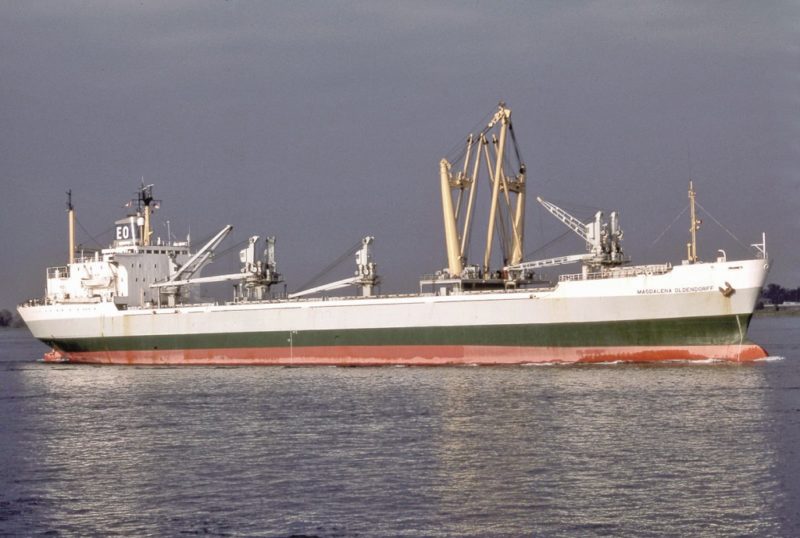
Alfred Oldendorff and Antonie Oldendorff, sisters of 93,700 dwt, were completed in 2015 as self dischargers to operate in the Persian Gulf alongside Anna Oldendorff of 88,266 dwt and Johanna Oldendorff of 67,500 dwt. The international pool fleet of self dischargers of CSL of Canada, Marbulk of Salem, and Klaveness of Norway gained Sophie Oldendorff, Harmen Oldendorff and Alice Oldendorff when sold in mid 2019 by Oldendorff for $100 million to Algoma Central Corporation of Canada, the third partner in the CSL Canada pool, to continue operations. There are currently ten self dischargers owned by Oldendorff, with two newbuildings of 27,000 dwt for completion in 2021 for operation in Vietnam, and four smaller self dischargers of 13,400 dwt named Eagle, Falcon, Hawk and Osprey, as well as three reloaders, three floating cranes, 26 barges, a dozen tugs and eight service craft in the transhipment trades. This adds up to a big total of 57 ships and small craft operating in the self discharging and transhipment trades.
Oldendorff have five transhipment projects around the world in shallow water in Iskenderun in Turkey, Guyana, Vietnam, Trinidad and Musaffah Port for Emirates Steel in the United Arab Emirates (UAE). Three large reloaders are used for transhipment named Isken, Volga and E. Oldendorff, the latter specially converted for the purpose in China in 2008 with a loading rate of 30,000 tonnes per day. The current huge Oldendorff transhipment cargo total in 2020 was over 30 million tonnes per year.

KLAUS EGON OLDENDORFF
The eldest son of Egon Oldendorff was named Klaus Egon Oldendorff on his birth on 14th April 1933, and served time in his father’s chartering office in Hamburg during 1951/54, and was appointed Head of Superintendents at the age of 21 years. He then gained further valuable experience in shipping offices in England and Sweden before setting up on his own as a shipowner in Teilfeld Strasse in Hamburg on 12th December 1964.
The twin hold coaster Bockholm of 956 grt and 1,417 dwt was purchased on the same day and sailed from Kiel in ballast for the White Sea to load timber on the same evening. On the following day, Klaus Egon Oldendorff began work as the sole shoreside employee in his office. Bockholm was renamed Nordholm on this day, and had been built in 1956 by the Sieghold yard in Bremerhaven as Max Sieghold for Parten Reederei Sieghold and registered in Bremerhaven. She traded for Klaus Egon Oldendorff for five years until sold in 1969 to Giuseppe Looz of Naples and was renamed Maria L, eventually arriving in Naples on 15th December 1985 for breaking up. The ‘Nord’ prefix of the ships and Reederei ‘Nord’ came from Nordische Dampfer Reederei, founded by his father Egon as a liner service between Lubeck and Scandinavia, but was discontinued in 1929 at the start of the Great Depression.
The second ship owned by Klaus Egon Oldendorff was purchased in April 1965 as a four hold ‘tween decker of 5,160 dwt built in 1951 by the Flensburger yard as Levante on dimensions of overall length 382.0 feet and moulded beam of 21.0 feet with a service speed from her diesel engine of 13 knots and was renamed Nordmark.
The next two ships owned by Klaus Egon Oldendorff were purchased in 1966 as the elderly, three hold quarterdeck sisters Nordlore and Nordeide of 2,463 grt and 3,180 dwt and had been built in 1948 for Norwegian owners. They were of overall length 93.2 metres, moulded beam of 13.2 metres, moulded depth of 6.3 metres and a loaded draft of 5.61 metres. The grain capacity was 172,664 cubic feet and their bale capacity was 162,664 cubic feet, with a service speed of 11 knots from a diesel engine of 1,350 bhp. They gave three years of trading to Oldendorff, and Nordlore was sold to Greek owners in 1969 but kept her name until she arrived at Perama in March 1979 after suffering a bad fire on 1st June 1978 at Piraeus and had been laid up.
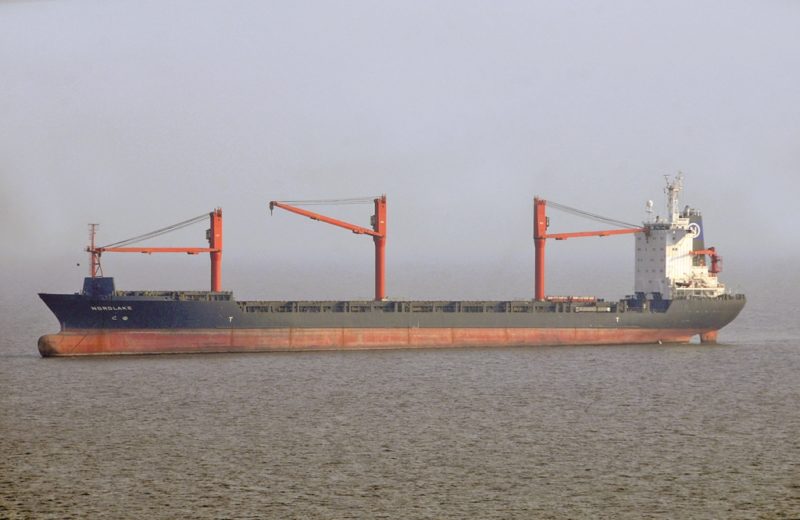
The fifth ship owned by Klaus Egon Oldendorff in 1967 was the former five hold ‘tween decker Niedersachsen of 4,313 grt and 6,370 dwt built by the Weser Seebeck yard at Bremerhaven in 1954 for Hugo Stinnes and his Parten Reederei Niedersachsen and registered in Hamburg. She had five holds and had a service speed of 15 knots from her M.A.N. diesel engine, and had accommodation as built for ten passengers on her trade routes to South America. However, freight rates in 1970 plummeted to low depths and all of the second hand ships were sold off, with Nordfels the last to go in 1971 when sold to Erjac Ocean Lines of Famagusta with her name and management retained by Klaus. She eventually arrived at Gadani Beach on 15th November 1986 for breaking up under the name of Michael K.
Klaus Egon Oldendorff entered the newbuild market in 1969 with the purchase of four of a series of ten engines aft ‘Trampko’ types ordered by the members of the Hamburg Trampship Owners Co-operative from the Schlicting Werft yard at Travemunde.
This quartet were part container ships with capacity for 228 TEU of containers on a deadweight of 7,435 tonnes. Nordwelle, Nordwoge, Nordkap and Nordstrand were given two heavy lift derricks of 60 tonnes capacity and ten of 10 tonnes capacity on two masts. They tramped in the Mediterranean and Eastern Seaboard of the U.S.A. trades until Nordwelle was sold in 1977 to French owners and renamed Mejean III. Nordwoge was half owned by Klaus and his father Egon, although managed by his father. A total of 18 vessels of this ‘Trampko’ type with a service speed of 15.5 knots had been built by the mid 1970s for German and European shipowners.
The Klaus Egon Oldendorff fleet expanded over the next decade and gained a reputation for quality ship management. Six vessels of between 7,700 dwt and 8,200 dwt were managed in 1978 named Nordfels, Nordheim, Nordholm, Nordkap, Nordstrand and Nordwoge including four further ‘Trampko’ types built in Japan.
The fleet had expanded to eight ships in 1982 with the addition of the similar Nordheide, Nordmark, Nordwelle and Nordwind after two ships had been sold. Nordmark was aground at Duala in late December 1980 while on a voyage from Hamburg to Matadi after suffering steering troubles, and sailed from Duala on 17th January 1981 after repairs.
A new Nordwoge of 12,665 dwt was completed in 1984 as Klaus Egon Oldendorff moved into the bulk trades of bigger contracts of affreightment with a fleet of a dozen ships owned and managed in 1987. Five of this fleet also had container capacity in an effort to remain in the container segment of world shipping, which has continued to the present day.

During the 1980s decade, conditions for shipowners in Germany became very difficult during the oil and shipping crises, and with crippling taxes it was decided by Klaus Egon Oldendorff that if the ‘Nord’ fleet was to continue trading successfully, then it must move to another country. After careful consideration by Klaus, his wife Christiane, and their twin sons Christian and Nikolaus, the family moved to Limassol in Cyprus in January 1987.
The Oldendorff tower office block on the Limassol seafront of Libra Tower was soon managing and operating a big fleet of 36 ships of over 2.5 million dwt, the biggest tonnage fleet based in Cyprus. The dark blue Oldendorff houseflag with a white ‘N’ inside a thin white ring was visible on the Head Office façade.
The first Panamax bulker, Nordbulk of 65,434 dwt, was completed in 1991 and traded worldwide e.g. coal from Richards Bay in Natal province of South Africa to Japanese ports or Kaohsiung.
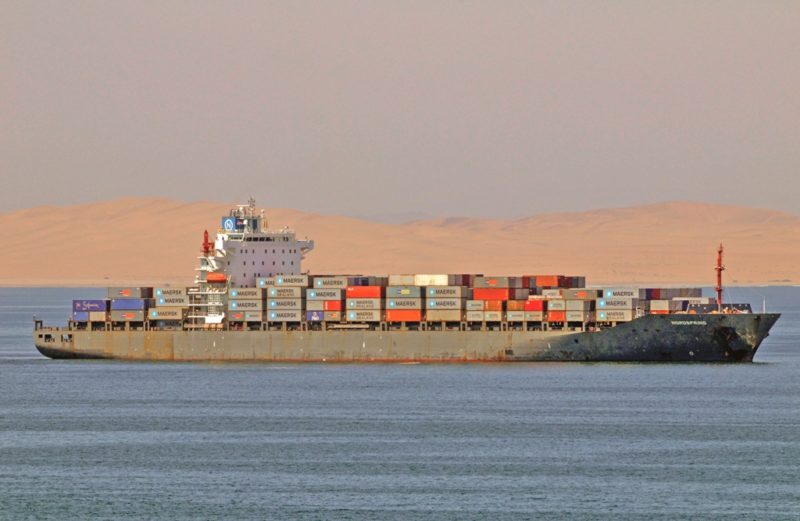
Three more Panamax bulkers had joined the fleet by 1995 in the new Nordmax and Nordmoritz of 72,500 dwt, with Nordscout of 64,500 dwt joining as a second hand purchase and had been built in 1981.
There were also Handysize bulkers of around 24,000 dwt in Nordcloud, Nordlake, Nordwoge, and vessels with good container TEU carrying capacity in Nordisle, Nordkap, Nordlight and Nordsino.
A big fleet was being traded in 1998 of two dozen ships in four big Panamax bulkers, sixteen container ships, and four general cargo ships with good container capacity, all with ‘Nord’ names except for the container ships that were almost always out on charter and took their charterer’s names.
The container ship Nordlake of 1,524 TEU capacity and 22,420 dwt with a service speed of 19.0 knots from a Sulzer diesel engine had been completed by the Stocznia Szczecin yard in Poland in 1994, and had taken four one year charters to Hanjin, Maersk Line, CMA-CGM and MOL of Japan by 1998.
A group of four UCC-14 container ships of Nordsun, Nordsky, Nordbeach and Nordcliff had been completed in 1991 of 1,050 TEU capacity and 14,100 dwt on dimensions of overall length 156.7 metres, moulded beam of 22.9 metres and loaded draft of 8.6 metres and a service speed of 17.8 knots from a Sulzer diesel engine of 7,960 kilowatt power.
The most interesting general cargo ship was Nordluck of 10,962 dwt that had been completed in 1984 as Ragna Bakke as the last ship of the well known ‘Bakke’ fleet of Knut Knutsen O.A.S. of Haugesund in Norway and his Norwegian South Pacific Line. She was purchased by Oldendorff in 1991 and taken on a Far East charter as Tiger Bridge along with another general cargo ship chartered out as Tiger Bay. Nordluck had dimensions of overall length of 134.4 metres, moulded beam of 20.8 metres, six holds, twelve hatches and could carry a good number of 798 TEU of containers on a loaded daft of 7.9 metres at a service speed of 14.0 knots.
The crude oil and products tanker segments were entered at this time in late 1997 with two new tankers of 90,000 dwt in Nordstrength and Nordmark.
A tanker pool was created with Torm of Denmark in 1999, and six VLCC tankers of 302,000 dwt and six Aframax tankers of 105,000 dwt were delivered that year for trading in the pool from the Persian Gulf to the Gulf of Mexico, particularly Galveston and Houston. The ‘Nord’ tanker fleet had reached ten tankers in size by 2003 with four more on order, with three VLCCs of 301,400 dwt in Nordmillennium built in 2000 and sisters Nordenergy and Nordpower built in 2003.

Nordmillennium arrived in August 2003 at the Maasvlakte Oil Terminal at Rotterdam with crude oil on one of her regular voyages to the biggest port in the world. The remaining Reederei ‘Nord’ tankers were of 75,000 dwt and named Nordmars, Nordmerkur, Nordmoritz, Nordmosel, Nordneptun, Nordvenus and Nordbay. The tanker fleet later traded in the LR1 Pool of 31 tankers of Oldendorff Reederei Nord, Nordic Tankers A/S, Norden Tankers Inc, Skagerak Investments, Gotland Shipping and Torm A/S of Denmark.
The VLCCs Nordenergy and Nordpower were named by Mrs. Christiane Oldendorff at a joint ceremony at the Samho Heavy Industries yard in South Korea in late 2003, before they ballasted to the Persian Gulf to load their maiden cargoes of crude oil.
The sad death of Klaus Egon Oldendorff occurred on 17th March 2003 from a heart attack while in Switzerland on a skiing holiday just one month before his 70th birthday. He had been at his desk on the Limassol seafront only three days before his death, and had directed his senior staff on matters of some importance before going on holiday. He was an enthusiastic yacht sailer and was frequently seen sailing from the marinas at Limassol and Paphos.
Christiane, his wife, stepped into the role of company Chairman and Managing Director, and she and her twin sons returned to Hamburg in 2005 after the introduction of financial measures such as the Tonnage Tax had made Germany an attractive location again.
The Reederei Nord container ship fleet in 2009 comprised twenty container ships, as well as the tanker fleet, and six Panamax bulkers named Nordelbe, Nordems, Nordmosel, Nordrhine, Nordtrave and Nordweser.
The container ships were up to 3,586 TEU in capacity, and were named Nordcoast, Nordeagle, Nordfalcon, Nordhawk, Nordpartner, Nordatlantic, Nordcloud, Nordautumn, Nordbaltic, Nordriver, Nordsea, Nordstar, Nordsun, Nordsummer, Nordwelle, Nordwinter, Nordwoge, Nordspring, Nordmed and Nordlake. However, they were rarely seen with these names, as they had almost always been out on charter to CMA-CGM, MOL, Zim Line, Maersk Line, Safmarine, CSAV of Chile, DAL Afrika Line, Libra Line, P. & O. Lines, PIL of Singapore, UACC and Hapag-Lloyd, and various other lines in Panamerica and the Far East.
Nordlake had a serious collision on 30th January 2011 with the Indian frigate Vindhyagiri (F42) in the Port of Mumbai, with the frigate having to be broken up.
Christian Oldendorff and Nikolaus Oldendorff, twin sons of Klaus Egon Oldendorff, gained ultimate control of the company after the demise of their father, and began purchasing vessels for the Reederei ‘Nord’ in 2011.
Christian Oldendorff purchased his first product tanker of 74,000 dwt in May of that year for $38.6 million from Eagle Tankers as Eagle Hope and built in 2008, which was renamed Two Million Ways, rather than having a ‘Nord’ prefix name, as the prefix was dropped from the fleet at that time.
The fleet in 2016 was a big one of 50 ships with six more on order, including ten tankers of up to 300,000 dwt, 28 container ships of up to 3,586 TEU capacity, and a dozen bulkers of up to Panamax size. The newbuildings were on order from the Guangzhou Wenchong and Jiangsu Hantong yards in China.
The size of the fleet in 2021 has remained the same as in 2016, with eleven bulk carriers in the range of 37,500 dwt to 38,500 dwt, sixteen tankers of up to 116,000 dwt including two chemical tankers, and 26 container ships in the range from 1,700 TEU to 3,500 TEU capacity.
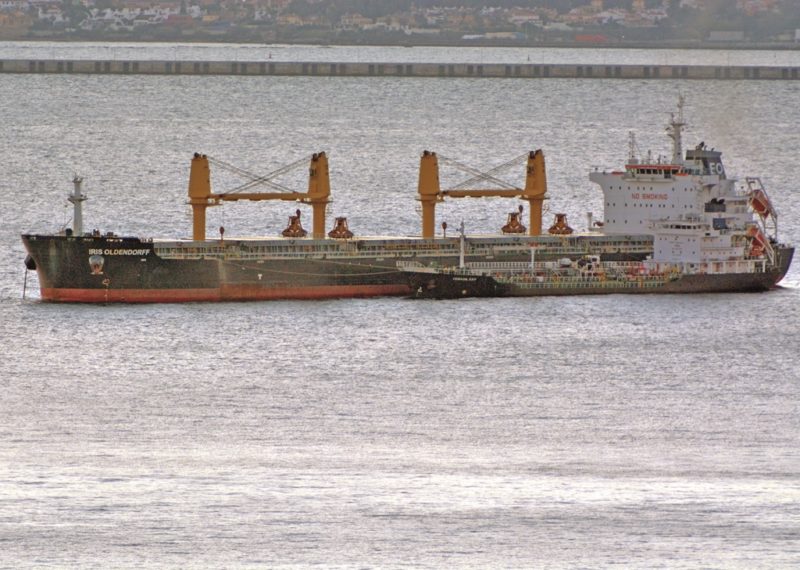
The size of the ‘Nord’ fleet is now around 3 million dwt, with commercial chartering via three separate pools:-
Hanseatic Unity Chartering Pool for container ships in a pool of Reederei Nord, Asiatic & Atlantic Lloyd, Leonhardt & Blumberg, Borealis Maritime and Bernhard Schulte.
Hanseatic Unity Handysize Chartering Pool for bulk contracts of affreightment as well as single voyage charters for bulkers, with a dozen bulkers owned by Reederei Nord in the pool.
The N2 Tankers Pool, which was set up in May 2020 by Reederei Nord and the Synergy Group, a managing partner on behalf of Nissen Kaiun of Japan, as a new Aframax tanker pool of 15 tankers built to the highest standards between 2007 and 2018. The twin Head Offices of Amsterdam for commercial management of tankers in the western world, and Singapore for those tankers in the eastern world, will make N2 Tankers one of the leading Aframax tanker pools in the world. Pusaka Laut, a Singapore shipowner, has one tanker in the pool, and the tanker Nordsymphony of 106,200 dwt and built in 2008 was recently welcomed to the pool as a new entrant.
The Reederei ‘Nord’ Group is managed by three separate companies:-
Reederei ‘Nord’ Gmbh with Head Office in Hamburg, founded in 1964 with a focus on dry bulk and container tonnage.
Reederei ‘Nord’ B.V. with Head Office in Amsterdam founded in 2013 with a focus on tanker tonnage.
Reederei ‘Nord’ Shipmanagement Ltd. with Head Office in Limassol founded in 1986 with a focus on tanker ship tonnage and third party management services.
All managed vessels are owned by private shipowners and commercial investors, with management of vessels including commercial, financial and accounting, technical, crewing, safety and security, vetting and newbuild supervision.
The crews of vessels are drawn from many countries throughout the world, with a minimum of 21 seafarers per ship plus two cadets and depending on the size and type of the vessel.
POSTSCRIPT
Henning Oldendorff of the Lubeck based Reederei Oldendorff, and the twin brothers Christian Oldendorff and Nikolaus Oldendorff of ‘Nord’ Reederei of Hamburg, today control vast fleets that trade worldwide.
The very famous name of Oldendorff has come a very long way in the one hundred years from a small coastal fleet founded by Egon Oldendorff, to operate very important bulk fleets that straddle the globe in a network of trading empires.
The advantages of family run businesses are that profits can be retained instead of being paid out in huge dividends to shareholders, which can be reinvested in the business when the time is right. This allows them to ride out seriously difficult times and then take advantage of opportunities that a weak market presents in the time honoured ‘buy low and sell high’ strategy.
The funnel colours of Reederei Oldendorff now have changed to a red base with a grey top and a central dark blue band bearing ‘EO’ in white, and the huge time chartered fleet wear charterer’s funnel colours.
I wish to send everyone at the 17 Branch offices worldwide of Reederei Oldendorff, and those working at the Head Office at Lubeck very best wishes for the next one hundred years.




Comments
Sorry, comments are closed for this item